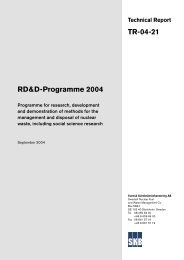Read/Download - SKB
Read/Download - SKB
Read/Download - SKB
- No tags were found...
Create successful ePaper yourself
Turn your PDF publications into a flip-book with our unique Google optimized e-Paper software.
2 Objectives and scopeThe main objectives of drilling deep telescopic boreholes at the site investigation are thefollowing:• To provide rock samples from the ground surface to the borehole bottom. Percussion drillingthrough the overburden produces soil samples recovered to the surface by compressed air.These samples are collected with a frequency of one sample per metre. The same samplingfrequency is applied for the drill cuttings produced when percussion drilling the upperc. 100 m of the solid rock. Below 100 m, the core drilling provides (in principle) continuousdrill cores down to the borehole bottom. A short core borehole, KFM06B, was drilledearlier from the drill site to compensate for the missing core of the upper 100 m. The rocksamples collected during drilling are used for lithological, structural and rock mechanicalcharacterization as well as for determination of transport properties of the fracture systemfrom the rock surface to the full drilling depth.• To render geophysical borehole investigations possible, e.g. TV logging, borehole radarlogging and conventional geophysical logging as an aid for the geological/rock mechanicalcharacterization.• To allow hydraulic borehole tests (single hole tests as well as interference tests, in somecases performed as tracer tests) for characterization of the hydrogeological conditions.• To make water sampling possible down to and below repository depth. High-class hydrogeochemicalsampling/analysis demands special measures during and after drilling inorder to keep the borehole clean. When these measures have been taken, the borehole iscategorized as a borehole of chemical type. Only boreholes of this category are approvedfor advanced hydrogeochemical and microbiological characterization.• To enable long-term hydraulic and hydrogeochemical monitoring at different levels of thebedrock.During drilling, a number of drilling related parameters are monitored by a drilling monitoringsystem. Part of these data sets, in this report called DMS (Drilling Monitoring System) data,which after drilling are transferred to SICADA, may be used as supplementary data for geologicaland hydraulic characterization as well as for assessment of technical aspects of the drillingoperations. DMS-data are described in this report.Furthermore, a number of hydraulic tests and water samplings are normally performed duringthe drilling process, whereby a specifically designed test system, a so called wireline probe, isutilized.11
















